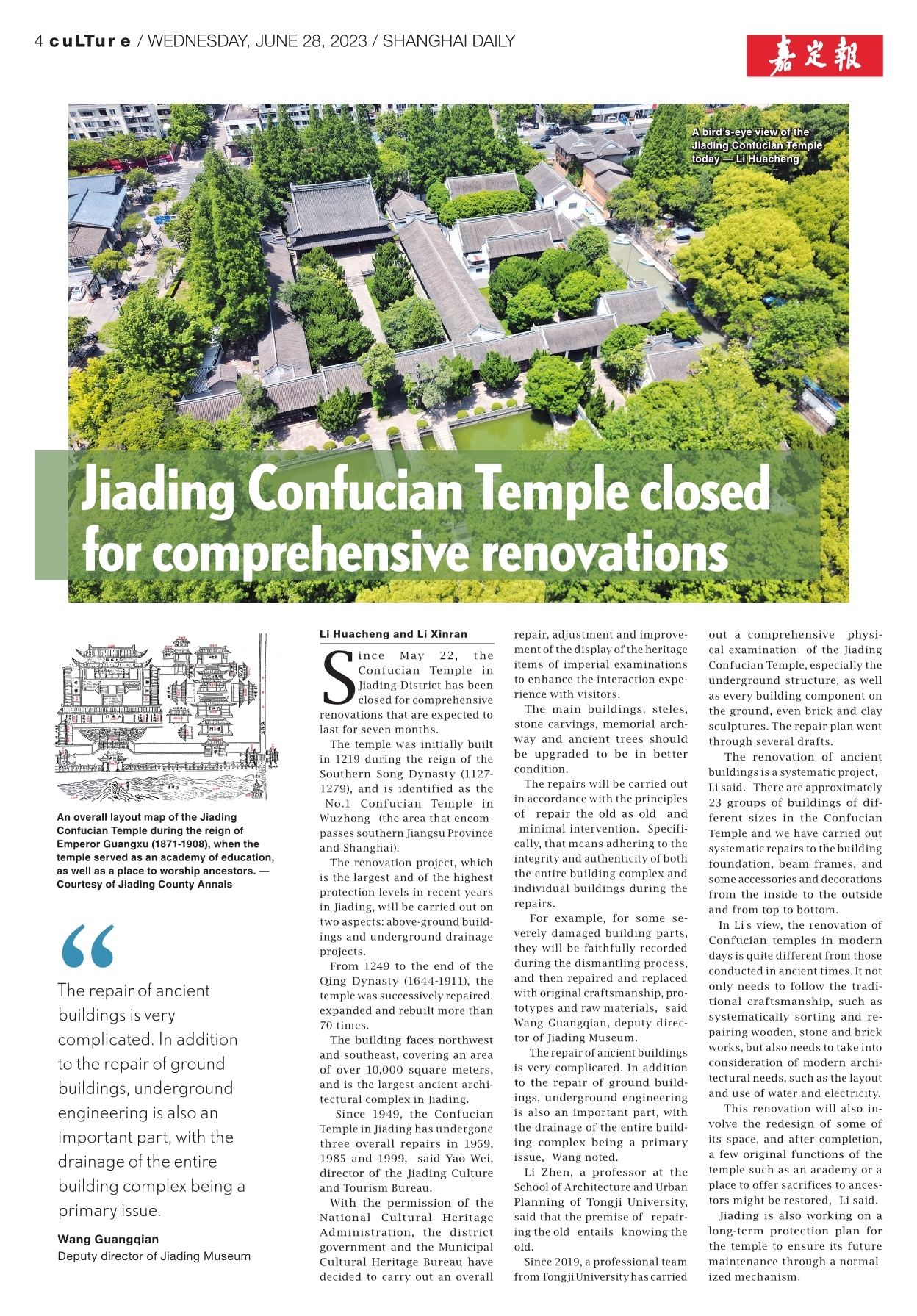

Jiading Confucian Temple closed for comprehensive renovations

A bird’s-eye view of the Jiading Confucian Temple today — Li Huacheng

An overall layout map of the Jiading Confucian Temple during the reign of Emperor Guangxu (1871-1908), when the temple served as an academy of education, as well as a place to worship ancestors. — Courtesy of Jiading County Annals
The repair of ancient buildings is very complicated. In addition to the repair of ground buildings, underground engineering is also an important part, with the drainage of the entire building complex being a primary issue.
Wang Guangqian
Deputy director of Jiading Museum
Li Huacheng and Li Xinran
Since May 22, the Confucian Temple in Jiading District has been closed for comprehensive renovations that are expected to last for seven months.
The temple was initially built in 1219 during the reign of the Southern Song Dynasty (1127-1279), and is identified as the “No.1 Confucian Temple in Wuzhong” (the area that encom-passes southern Jiangsu Province and Shanghai).
The renovation project, which is the largest and of the highest protection levels in recent years in Jiading, will be carried out on two aspects: above-ground build-ings and underground drainage projects.
From 1249 to the end of the Qing Dynasty (1644-1911), the temple was successively repaired, expanded and rebuilt more than 70 times.
The building faces northwest and southeast, covering an area of over 10,000 square meters, and is the largest ancient archi-tectural complex in Jiading.
“Since 1949, the Confucian Temple in Jiading has undergone three overall repairs in 1959, 1985 and 1999,” said Yao Wei, director of the Jiading Culture and Tourism Bureau.
With the permission of the National Cultural Heritage Administration, the district government and the Municipal Cultural Heritage Bureau have decided to carry out an overall repair, adjustment and improve-ment of the display of the heritage items of imperial examinations to enhance the interaction expe-rience with visitors.
The main buildings, steles, stone carvings, memorial arch-way and ancient trees should be upgraded to be in better condition.
The repairs will be carried out in accordance with the principles of “repair the old as old” and “minimal intervention.” Specifi-cally, that means adhering to the integrity and authenticity of both the entire building complex and individual buildings during the repairs.
“For example, for some se-verely damaged building parts, they will be faithfully recorded during the dismantling process, and then repaired and replaced with original craftsmanship, pro-totypes and raw materials,” said Wang Guangqian, deputy direc-tor of Jiading Museum.
“The repair of ancient buildings is very complicated. In addition to the repair of ground build-ings, underground engineering is also an important part, with the drainage of the entire build-ing complex being a primary issue,” Wang noted.
Li Zhen, a professor at the School of Architecture and Urban Planning of Tongji University, said that the premise of “repair-ing the old” entails “knowing the old.”
Since 2019, a professional team from Tongji University has carried out a comprehensive “physi-cal examination” of the Jiading Confucian Temple, especially the underground structure, as well as every building component on the ground, even brick and clay sculptures. The repair plan went through several drafts.
“The renovation of ancient buildings is a systematic project,” Li said. “There are approximately 23 groups of buildings of dif-ferent sizes in the Confucian Temple and we have carried out systematic repairs to the building foundation, beam frames, and some accessories and decorations from the inside to the outside and from top to bottom.”
In Li’s view, the renovation of Confucian temples in modern days is quite different from those conducted in ancient times. It not only needs to follow the tradi-tional craftsmanship, such as systematically sorting and re-pairing wooden, stone and brick works, but also needs to take into consideration of modern archi-tectural needs, such as the layout and use of water and electricity.
“This renovation will also in-volve the redesign of some of its space, and after completion, a few original functions of the temple such as an academy or a place to offer sacrifices to ances-tors might be restored,” Li said.
Jiading is also working on a long-term protection plan for the temple to ensure its future maintenance through a normal-ized mechanism.
江苏路特数字科技有限公司 仅提供技术服务支持, 文字、图片、视频版权归属发布媒体


